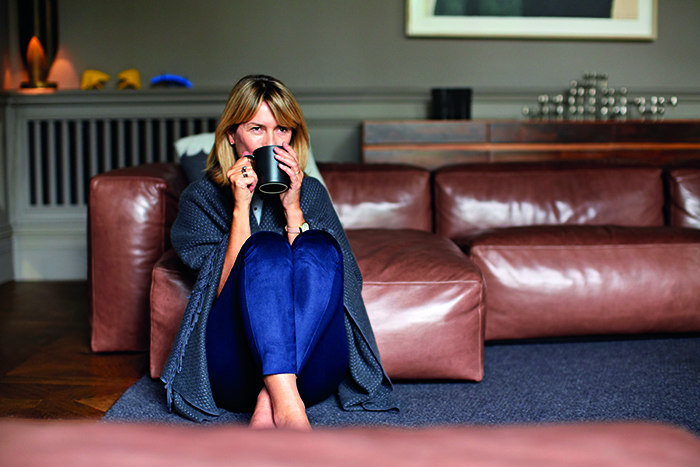Mindfulness can be applied to almost anything these days – even the humble cuppa! Make yours a moment for inner calm…
If you’re having a manic morning, feeling a bit frazzled or just in need of a quick ‘pick-me-up’, the simple act of making a cup of tea can be more beneficial than you think.
Zen Buddhist monks in 8th century China drank tea to keep them awake during long hours of meditation and also as a way of practising mindfulness. They held tea ceremonies where they would focus on all the five senses: sight, sound, taste, smell and touch. This helped to keep them mentally alert, energised and grounded. By the 12th century, tea ceremonies had spread to Japan and Korea.
The tea ceremony is still an important part of Eastern culture. Here in the West, we’re more likely to gulp tea on the go, on the train, or at our desks. But, by doing so, we’re missing out on so many mental and emotional benefits. Mindfulness is a very simple form of meditation. It’s about being totally present in the moment and focusing on what you’re feeling, seeing, smelling, hearing, tasting and touching. If you can do this, even for a few minutes, you’ll instantly feel calmer and more relaxed.
Create your own tea ceremony
Start by choosing a traditional Chinese or Japanese-style tea set. ‘Use your instincts when choosing a tea pot. This will be at the heart of hospitality in your home, so it has to feel right. Porcelain or bone china teapots are the most durable and less likely to chip. If you choose a glass teapot, you can see the colour of the tea as it brews. Or, you may prefer a traditional clay one.
Traditional Eastern-style teacups are usually much smaller than Western mugs and cups and have no handles. When you use smaller cups, it’s easier to drink tea more mindfully. When I perform a tea ceremony, I always get people to drink 2-3 cups. You might also want to experiment with a few different teas.
5 teas to try
Green
Green tea is ‘cooling’, calming and improves focus and mental clarity. The energy of green tea helps to rebalance your upper energy centres: your brow and crown chakras. Monks drink it to help them meditate, and one type of green tea, called Poet’s tea, is so called because it was traditionally used by Poets to clear their heads. Green tea is a great choice first thing in the morning as it wakes you up.
Black
The warming energy of black tea works on your lower energy centres, your sacral and base chakras, to help keep you grounded, centred, calmer and less stressed. Darker teas are also very good for digestion as well as your heart, circulation, mental alertness and for aiding meditation.
White
White teas are the most delicate. The young, silver leaves are picked carefully before the shoots open and while still free from chlorophyll (they would eventually turn green). White tea can help you to relax, slow down and feel a renewed lightness of spirit. It’s also associated with the emotion of grief, which is connected to the lungs and throat. If you’re feeling sad, drinking white tea can help you release these feelings.
Oolong
Made from the same leaves as black and green tea, oolong is only partially oxidised so it falls somewhere between the two (green tea is hardly oxidised while black tea is fully oxidised). Oolong is very calming and de-stressingand can help you think more clearly. It helps to regulate metabolism, digestion and blood sugar levels. It’s also excellent for soothing skin conditions such as eczema. You can drink it anytime but before bed is great as it helps induce relaxation and promote sleep.
Pu’er
Pu’er is very earthy, red tea that works on your solar plexus and helps to rebalance your digestive system. It’s produced in the Yunnan province and it’s the only tea that’s fermented. In China they call it ‘Miracle Tea’ as it’s very cleansing and energising. It can also help with weight loss as it speeds up metabolism. It’s also excellent for balancing hormones and can be very useful for menopausal women.
Top tea-making tips
- Always use a good quality loose tea. Seek out specialist companies that don’t sell hundred of teas – but, tend to focus on a smaller selection, from one country or region.
- Add 1tsp of loose tea per 150ml of water.
- Don’t use boiling water. If water is too hot, the heat will destroy some of the healing properties of the tea.
- For green and white tea, the water should be 70-80 degrees. Steep for 1-2 mins.
- For black tea, use water at 80 degrees and steep for 2-3 mins. Black tea can be brewed 2-3 times.
- For oolong go for 80 degrees and steep for 1 min. It can be infused up to six times but drain the water in between.
- For pu’er tea you want 85-degree water, and steep for 3-4 mins.
- Each tea is slightly different, so for best results always follow instructions on the pack.










